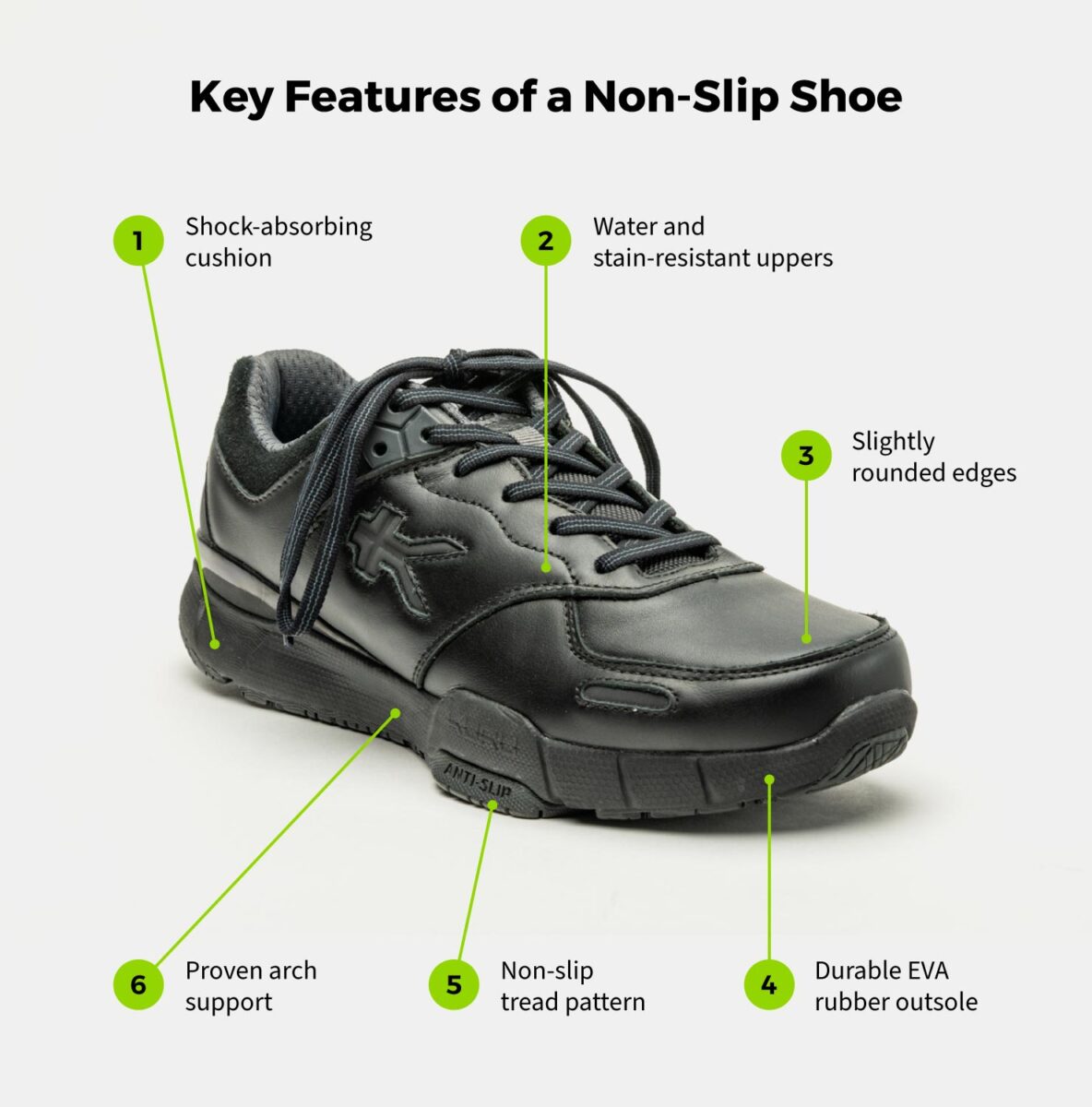Are you tired of slipping and sliding on slippery surfaces? Do you want to find shoes that provide the utmost safety and stability? Look no further! In this guide, we will explore the essential characteristics of non-slip shoes and equip you with the knowledge to determine if a pair of shoes is truly slip-resistant. Whether you’re a restaurant worker, a healthcare professional, or simply someone who wants to avoid accidents, understanding how to identify non-slip shoes is vital for your everyday life. Get ready to step confidently and securely as we dive into the world of slip-resistant footwear.
Thank you for reading this post, don't forget to subscribe!No one wants to experience the embarrassment and potential injuries that come with slipping on wet or greasy floors. That’s why it’s crucial to invest in shoes that offer superior traction and grip. But with countless brands and models available, how can you tell if a pair of shoes is truly non-slip? This guide will take you through the key features to look for, from specialized outsole materials to innovative tread patterns. We’ll also discuss the importance of industry certifications and standards to ensure the reliability of slip-resistant claims. Get ready to walk with confidence and peace of mind as we unveil the secrets to identifying non-slip shoes.
How to tell if shoes are non-slip:
- Check the outsole material – non-slip shoes usually have rubber or synthetic outsoles with a tread pattern for better traction.
- Look for a non-slip rating or certification, such as ASTM F2913-11.
- Inspect the shoe’s design – non-slip shoes often have a wider base and supportive features.
- Read customer reviews or ratings to see if others have mentioned the shoes being non-slip.

How to Tell If Shoes Are Non-Slip
When it comes to selecting the right shoes for certain activities or work environments, one important factor to consider is slip resistance. Non-slip shoes are designed with special outsoles that provide improved traction and grip, reducing the risk of slipping and falling. Whether you work in a restaurant kitchen, hospital, or any other place where slip hazards are common, knowing how to determine if shoes are non-slip is essential. In this article, we will guide you through the process of identifying non-slip shoes, ensuring you make a safe and informed choice.
Look for the Slip-Resistant Marking
One of the easiest ways to identify non-slip shoes is to look for the slip-resistant marking. Most reputable shoe manufacturers include a specific symbol or label on the shoe’s outsole to indicate its slip-resistant properties. This marking is typically a shoeprint with a series of lines or patterns, signifying its ability to provide traction on slippery surfaces. When shopping for shoes, pay close attention to the outsole and look for this marking as a clear indication that the shoe is designed to be slip-resistant.
However, it’s important to note that not all slip-resistant shoes have the same level of effectiveness. Different shoes are designed for specific types of environments and slip hazards. For example, shoes designed for restaurant workers may have a different slip-resistant rating compared to those intended for healthcare professionals. Therefore, it’s crucial to consider the specific requirements of your workplace when choosing non-slip shoes.
Check the Material and Tread Pattern
Another way to determine if shoes are non-slip is by examining the material and tread pattern of the outsole. Slip-resistant shoes are typically made from rubber or a similar material that offers excellent traction. Rubber outsoles are known for their grip on various surfaces and are commonly used in non-slip shoe designs. Additionally, the tread pattern on the outsole plays a crucial role in providing slip resistance. Look for shoes with deep and multidirectional treads, as they are more effective in preventing slips and falls.
It’s worth noting that the material and tread pattern alone may not guarantee slip resistance. Factors such as wear and tear, surface conditions, and the presence of oil or water can affect the shoe’s slip-resistant properties. Regular maintenance and proper cleaning of non-slip shoes are essential to ensure their continued effectiveness. Be sure to follow the manufacturer’s recommendations for care and maintenance to optimize the slip-resistant capabilities of your shoes.
Consider Independent Testing and Reviews
If you want further assurance that a pair of shoes is truly non-slip, consider looking for independent testing or reading reviews from reputable sources. Various organizations conduct slip-resistant testing on shoes and provide certifications or ratings based on their performance. These certifications can be valuable indicators of a shoe’s slip-resistant capabilities. Additionally, checking reviews from other customers who have already purchased the shoes can provide valuable insights into their effectiveness in real-world scenarios.
When relying on reviews, make sure to consider multiple sources to get a well-rounded understanding of the shoe’s slip-resistant qualities. Pay attention to comments about the shoe’s grip on different surfaces and whether users experienced any slips or falls while wearing them. By considering independent testing and reviews, you can make a more informed decision when selecting non-slip shoes.
Inspect for Other Safety Features
Besides slip resistance, it’s important to consider other safety features that may be necessary for your specific work environment. Some non-slip shoes come with additional features such as reinforced toe caps, electrical hazard protection, or waterproofing. Assess your workplace’s requirements and regulations to determine if any additional safety features are necessary. By considering these factors, you can ensure that your non-slip shoes not only provide excellent traction but also meet all the necessary safety standards.
Remember, slip-resistant shoes are designed to reduce the risk of slips and falls, but they are not foolproof. It’s crucial to remain vigilant and practice safe habits while wearing non-slip shoes. Be aware of your surroundings, watch out for potential hazards, and take necessary precautions to maintain your safety at all times.
Frequently Asked Questions
Are you looking for non-slip shoes to ensure safety in your workplace or daily activities? Here are some commonly asked questions about how to tell if shoes are non-slip, along with detailed answers to help you make an informed decision.
1. How can I determine if a pair of shoes is non-slip?
Non-slip shoes are designed with specific features to provide better traction and prevent slipping. To determine if a pair of shoes is non-slip, look for a visible pattern or texture on the sole. These patterns often consist of small, raised dots or lines that increase friction with the ground. Additionally, non-slip shoes may also be labeled as “slip-resistant” or “grip-enhancing.” Keep in mind that not all shoes with textured soles are non-slip, so it’s important to check for additional features or certifications.
Furthermore, some non-slip shoes undergo specific tests to measure their slip resistance. Look for shoes that meet industry standards, such as ASTM F2913-11, which evaluates the coefficient of friction between the shoe and different surfaces. These certified shoes have undergone rigorous testing to ensure their slip-resistant properties.
2. Can I rely solely on the appearance of the sole to determine if shoes are non-slip?
While the appearance of the sole can provide some indication of slip resistance, it’s not the sole factor to consider. Many non-slip shoes have a clear and subtle textured pattern, making it difficult to identify their slip-resistant qualities based on appearance alone. To ensure accuracy, it’s essential to look for additional indicators, such as shoe labels or certifications that explicitly state slip resistance.
Rather than solely relying on visual cues, consider reading product descriptions or reviews to gather information about a shoe’s slip-resistant features. Manufacturers often provide detailed specifications and test results, giving you a better understanding of the shoe’s performance on different surfaces.
3. Are all non-slip shoes suitable for all environments?
While non-slip shoes are designed to enhance traction and reduce the risk of slipping, not all shoes are suitable for every environment. Different industries and activities may require specific types of non-slip shoes. For example, shoes designed for restaurant workers may have additional features like resistance to oil and grease spills.
Consider the specific environment in which you’ll be using the shoes and look for features that cater to those conditions. If you work in a hospital, shoes with non-slip soles that are also easy to clean and disinfect may be more suitable. Assessing your needs and the demands of your environment will help you choose the right pair of non-slip shoes.
4. Can I wear non-slip shoes for daily activities outside of work?
Absolutely! Non-slip shoes are not limited to workplace use only. They can be beneficial for various daily activities, such as hiking, walking on slippery surfaces, or even during rainy weather. Non-slip shoes provide an extra layer of safety by reducing the risk of accidental slips and falls.
When selecting non-slip shoes for everyday use, consider comfort, durability, and style in addition to their slip-resistant qualities. Look for shoes that offer all-day comfort and support, as well as a design that matches your personal style preferences.
5. How often should I replace non-slip shoes?
The lifespan of non-slip shoes depends on several factors, including frequency of use, intensity of activity, and overall wear and tear. It’s important to regularly inspect your non-slip shoes for signs of deterioration, such as worn-out soles, reduced traction, or visible damage. These signs indicate that it may be time to replace your shoes.
On average, non-slip shoes should be replaced every six months to a year for optimal performance. However, it’s crucial to assess the condition of your shoes regularly and replace them sooner if necessary. Investing in new non-slip shoes when needed ensures your safety and maintains the effectiveness of the slip-resistant features.

In conclusion, being able to identify non-slip shoes is crucial for ensuring safety and preventing accidents in various settings. By paying attention to the sole material, tread design, and certification labels, individuals can confidently choose footwear that provides the necessary traction on slippery surfaces. Additionally, seeking advice from professionals and reading customer reviews can further enhance one’s ability to distinguish non-slip shoes from regular ones.
It is worth emphasizing that investing in non-slip shoes is not only beneficial for personal safety but also for the well-being of others. Whether you work in the hospitality industry, healthcare sector, or simply want to navigate slippery environments with confidence, having the right footwear is essential. By following the guidelines outlined in this guide and staying informed about advancements in shoe technology, individuals can make informed decisions that prioritize safety and minimize the risk of accidents caused by slippery surfaces. Remember, when it comes to non-slip shoes, prevention is always better than a painful slip and fall.

